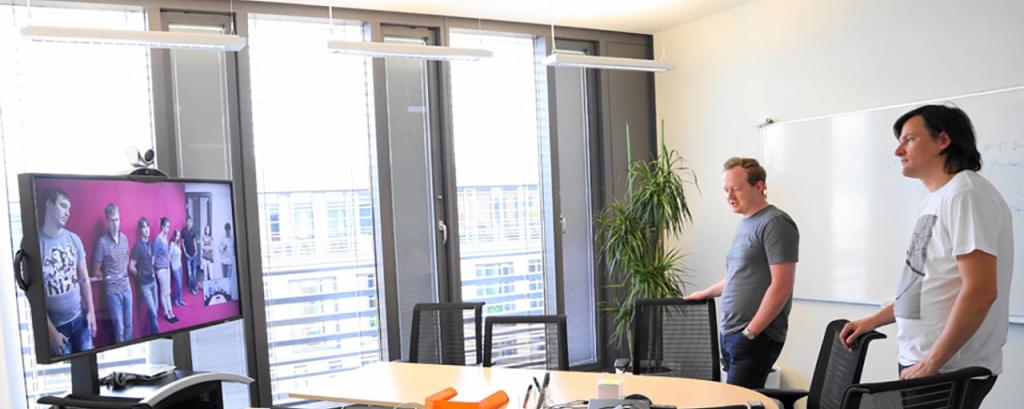"What I like the most about Zendesk is the transparency. You can easily find any ticket and see everything related to it: ticket history, ticket evidence, everything can be displayed. We are indeed looking at a single source of truth for our customer service.”
- Jiří Fait
Helpdesk Administrator 在 JetBrains
30,000
Tickets/mo
97%
CSAT
30%
Admin workload reduction
5
Custom apps
JetBrains is one of the most revered brands among technology developers. Its host of tools, including products like IntelliJ IDEA, PyCharm, and PhpStorm, are made by developers, for developers.
Headquartered in Prague, Czech Republic, the global enterprise software company makes coding a more productive and enjoyable experience by automating routine tasks to allow for more creative space and faster product delivery—as evidenced by the five million developers and project managers across 170,000 companies who use JetBrains tools. The company has also fostered and grown a robust and engaged global online community.
Given its sophisticated client base and highly specialized market, JetBrains must offer equally sophisticated support. Seasoned experts must provide fast and spot-on replies across a variety of languages, channels, and products—which is why the company adopted a flexible omnichannel solution from Zendesk, one that they could customize and build upon.
It was back in 2012 that JetBrains began to feel the need for an integrated support system and began using a few test instances of Zendesk Support. At the time, most support was done by email. “People would manually move messages around into folders,” said Mikhail Vink, a global marketing programs manager.

Use of Zendesk stuck—and caught on—and by 2013, there were 10 working instances of Support across a few different teams. “The teams migrated to Zendesk independently and did not build many integrations in the beginning,” Vink explained. As the company grew, its structure required a system that could share data to better connect remote teams in the United States and Europe. They decided to switch to a single instance of Zendesk Support and to make use of the Multibrand feature, thereby standardizing use of Zendesk across the company.
It was Vink who oversaw the merge of the 10 instances. “We got up to a few thousands of tweaks and automations, just because we had to handle all relationships within the system,” he said. The mission was complex and needed some fine-tuning but Vink and his colleagues were able to deliver the expected results—a consolidated, unified system that anyone in the company, anywhere in the world, could access. Thus began a new era of customer communication and increased productivity. “We got a good boost in terms of sharing tickets between different departments,” said Vink. “The support administration workload related to ticket sharing and routing decreased by almost 30 percent,” Vink explained.
The consolidation of support, with careful attention to workflows, has translated into faster, more relevant service and improved customer satisfaction, which today averages at 97 percent. “The business rules in Zendesk are very well-developed,” added Jiří Fait, JetBrains’ help desk administrator. “For example, we were able to set up special triggers that detect certain topics or mentions and route tickets to the responsible department.”

With the move to Multibrand, the team also integrated Zendesk with JetBrains’ CRM. “Zendesk allowed us to mitigate the complexity of working with tickets in many different languages from countries all over the world,” Vink said.
To communicate more efficiently, tickets from known customers are routed to the relevant department based on country of origin, assigned account manager, and other factors. This allows them to avoid pitfalls of regional miscommunication such as different holiday schedules and timezones. After the integration, JetBrains’ sales team reduced workload by 15 percent, thanks to the automated routing. “Before Zendesk, routing these tickets was a full-time job for one of our employees. The job title was ticket dispatcher, I believe,” Vink said. “This employee has now happily moved on to more creative tasks.”
Overall JetBrains receives more than 30,000 tickets each month, most of which are specific, technical questions about the inner workings of its complex tools. About half of the tickets are sales queries. All requests are handled by a team of more than 160 agents, who offer support in English, Chinese, Russian, German, Japanese, French, Czech, Spanish or Tamil. Requests are automatically routed to specific agents based on the language in which a customer submits a request.

Previously, email accounted for 98 percent of contacts—compared to 38 percent in 2018. Most requests now come through the web form, where users can submit a well-structured request which is then smartly and automatically routed to the relevant department. Twitter has also emerged as a small, but lively communication channel, accounting for 3 percent of volume. The company also actively posts educational videos and answers user questions on YouTube via Zendesk.
The company’s thriving community forums also represent another key channel. In 2016, the company migrated its forums from two other platforms to Zendesk Guide. “It was a one year project for us,” Vink recalled. “But with this shift, we made sure that community forums are treated as an additional public support channel, with a corresponding focus of our support engineers to make sure that questions not handled by the community get attention from our own staff.”
JetBrains transferred more than half a million forum messages into Zendesk Guide, where they remain available as an important component of the company’s self-service offerings. The massive knowledge base also includes another 500+ net-new articles, all to ensure that customers who want to self-serve, can. During the year that JetBrains focused on its self-service strategy, the number of sales-related tickets dropped by 10 percent—despite the total number of users increasing by approximately 30 percent over the same period of time.
JetBrains’ communities are not just a source of knowledge for other users. They are a vibrant and engaged community of developers helping each other find the best solution for a pesky problem or fine-tune a particular tool. “We get about 2,500 comments a month from our communities,” said Fait. “Users often answer questions from other users before our support team has a chance to reply. These posts are closed when answered, by support or by other users. Then we consolidate the answers in our knowledge base via Zendesk Guide.” Forum messages are collected by an app that JetBrains developed using the Zendesk Platform.

“Even before the Zendesk channel framework was introduced, we set up the Twitter and Facebook integrations,” said Vink. “After that, we developed an app for our marketing team so they can get all comments from YouTube in Zendesk.”
Next came custom-built apps for connecting Docker Hub, Stack Overflow, and processing suspended tickets. The team also purchased an app that connects Zendesk with the popular Chinese messaging platform WeChat—all in service of that ongoing commitment to meet customers where they are.
“With Zendesk, we no longer need to route customers to the channels most convenient for us,” Vink said. “We believe that we need to be there for customers via the channels convenient for them—not the channels that are most convenient for the company.”
JetBrains has made its apps available for others to use, too. “We maintain this service for some other companies just because it’s fun,” said Vink. “We have about 700 other Zendesk users using these applications, mainly the YouTube app.”
The future holds even more innovation as JetBrains expands in Asia and developers work to integrate local forums, social networks, and messenger type services into the Zendesk ecosystem. It’s complex, but Zendesk’s omnichannel approach keeps it simple. Vink explained, “Our agents don’t have to keep all the channels in mind: today they spend 90 percent of their response time in Zendesk.”
